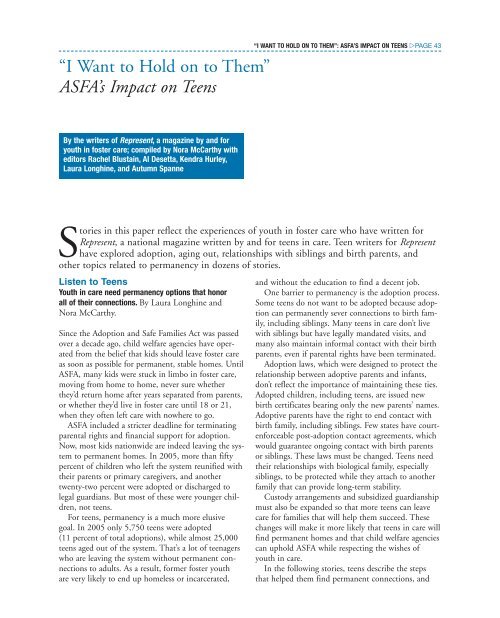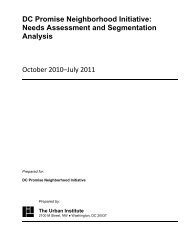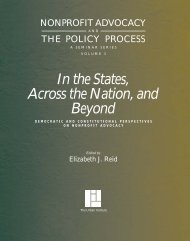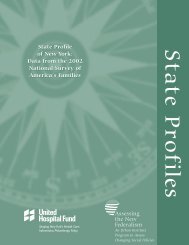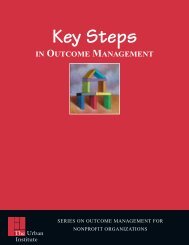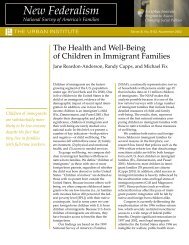Intentions and Results: A Look Back at the Adoption ... - Urban Institute
Intentions and Results: A Look Back at the Adoption ... - Urban Institute
Intentions and Results: A Look Back at the Adoption ... - Urban Institute
You also want an ePaper? Increase the reach of your titles
YUMPU automatically turns print PDFs into web optimized ePapers that Google loves.
“I Want to Hold on to Them”<br />
ASFA’s Impact on Teens<br />
By <strong>the</strong> writers of Represent, a magazine by <strong>and</strong> for<br />
youth in foster care; compiled by Nora McCarthy with<br />
editors Rachel Blustain, Al Desetta, Kendra Hurley,<br />
Laura Longhine, <strong>and</strong> Autumn Spanne<br />
Listen to Teens<br />
Youth in care need permanency options th<strong>at</strong> honor<br />
all of <strong>the</strong>ir connections. By Laura Longhine <strong>and</strong><br />
Nora McCarthy.<br />
Since <strong>the</strong> <strong>Adoption</strong> <strong>and</strong> Safe Families Act was passed<br />
over a decade ago, child welfare agencies have oper<strong>at</strong>ed<br />
from <strong>the</strong> belief th<strong>at</strong> kids should leave foster care<br />
as soon as possible for permanent, stable homes. Until<br />
ASFA, many kids were stuck in limbo in foster care,<br />
moving from home to home, never sure whe<strong>the</strong>r<br />
<strong>the</strong>y’d return home after years separ<strong>at</strong>ed from parents,<br />
or whe<strong>the</strong>r <strong>the</strong>y’d live in foster care until 18 or 21,<br />
when <strong>the</strong>y often left care with nowhere to go.<br />
ASFA included a stricter deadline for termin<strong>at</strong>ing<br />
parental rights <strong>and</strong> financial support for adoption.<br />
Now, most kids n<strong>at</strong>ionwide are indeed leaving <strong>the</strong> system<br />
to permanent homes. In 2005, more than fifty<br />
percent of children who left <strong>the</strong> system reunified with<br />
<strong>the</strong>ir parents or primary caregivers, <strong>and</strong> ano<strong>the</strong>r<br />
twenty-two percent were adopted or discharged to<br />
legal guardians. But most of <strong>the</strong>se were younger children,<br />
not teens.<br />
For teens, permanency is a much more elusive<br />
goal. In 2005 only 5,750 teens were adopted<br />
(11 percent of total adoptions), while almost 25,000<br />
teens aged out of <strong>the</strong> system. Th<strong>at</strong>’s a lot of teenagers<br />
who are leaving <strong>the</strong> system without permanent connections<br />
to adults. As a result, former foster youth<br />
are very likely to end up homeless or incarcer<strong>at</strong>ed,<br />
“I WANT TO HOLD ON TO THEM”: ASFA’S IMPACT ON TEENS �PAGE 43<br />
Stories in this paper reflect <strong>the</strong> experiences of youth in foster care who have written for<br />
Represent, a n<strong>at</strong>ional magazine written by <strong>and</strong> for teens in care. Teen writers for Represent<br />
have explored adoption, aging out, rel<strong>at</strong>ionships with siblings <strong>and</strong> birth parents, <strong>and</strong><br />
o<strong>the</strong>r topics rel<strong>at</strong>ed to permanency in dozens of stories.<br />
<strong>and</strong> without <strong>the</strong> educ<strong>at</strong>ion to find a decent job.<br />
One barrier to permanency is <strong>the</strong> adoption process.<br />
Some teens do not want to be adopted because adoption<br />
can permanently sever connections to birth family,<br />
including siblings. Many teens in care don’t live<br />
with siblings but have legally m<strong>and</strong><strong>at</strong>ed visits, <strong>and</strong><br />
many also maintain informal contact with <strong>the</strong>ir birth<br />
parents, even if parental rights have been termin<strong>at</strong>ed.<br />
<strong>Adoption</strong> laws, which were designed to protect <strong>the</strong><br />
rel<strong>at</strong>ionship between adoptive parents <strong>and</strong> infants,<br />
don’t reflect <strong>the</strong> importance of maintaining <strong>the</strong>se ties.<br />
Adopted children, including teens, are issued new<br />
birth certific<strong>at</strong>es bearing only <strong>the</strong> new parents’ names.<br />
Adoptive parents have <strong>the</strong> right to end contact with<br />
birth family, including siblings. Few st<strong>at</strong>es have courtenforceable<br />
post-adoption contact agreements, which<br />
would guarantee ongoing contact with birth parents<br />
or siblings. These laws must be changed. Teens need<br />
<strong>the</strong>ir rel<strong>at</strong>ionships with biological family, especially<br />
siblings, to be protected while <strong>the</strong>y <strong>at</strong>tach to ano<strong>the</strong>r<br />
family th<strong>at</strong> can provide long-term stability.<br />
Custody arrangements <strong>and</strong> subsidized guardianship<br />
must also be exp<strong>and</strong>ed so th<strong>at</strong> more teens can leave<br />
care for families th<strong>at</strong> will help <strong>the</strong>m succeed. These<br />
changes will make it more likely th<strong>at</strong> teens in care will<br />
find permanent homes <strong>and</strong> th<strong>at</strong> child welfare agencies<br />
can uphold ASFA while respecting <strong>the</strong> wishes of<br />
youth in care.<br />
In <strong>the</strong> following stories, teens describe <strong>the</strong> steps<br />
th<strong>at</strong> helped <strong>the</strong>m find permanent connections, <strong>and</strong>


